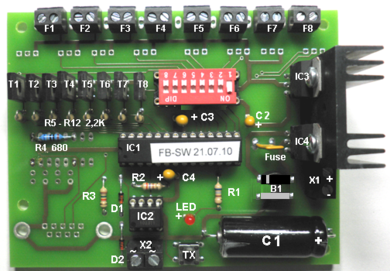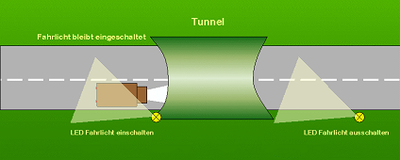Category:Function moduls, Function decoders ES
Function Modules
General
El módulo de funciones controla las funciones de un vehículo de DC Car, como luces o intermitentes, mediante LEDs IR, que se pueden colocar en el lateral de la carretera.
Este módulo de funciones tiene 8 salidas, cada una con un código diferente (función). Los 8 bloques de funciones (A-H) están preprogramados y mediante un interruptor dip se puede elegir sus funciones.
El módulo de funciones se entrega completamente montado e incluye 8 Emisores IR 3mm para distancia corta y 8 resistencias.
A function module transmits commands to a DC-Car decoder by means of a short range IR communication (10-20cm).
There are always 8 outputs available.
By using a dip switch 10 different module types are available
Supply voltage can be 12V - 16V AC or 12 - 16V DC
The outputs offer a current of 1A
By using a diode-circuit with 1N400x diodes it is possible to transmit multiple commands on one IR LED.
Stop module (All switches ON)
All switches ON Stop module means all 8 outputs sending a stop signal
Function Module ABasic Commands |
Function Module BFlashing Blue light vehicles | |
Function Module CAdditional lights and speed 1 = Light 2 ON |
Function Module DAutomatic parking |
Function Module EBus automatic |
Function Module FTechnic | |
Function Module GEmergency vehicles |
Function Module HStandard mix |
Function Module IRemote control |
Function Module J MF3, MF4 and MF5 functions(from 8.2016) |
IR-LED on/in the street
Mounting of the IR-LED on the site:
The IR-LED is placed in or nearby the street in such a way that the cars can "see" the IR-light, emitted by the LED and execute the transmitted function at the intended place.
The IR-LED must be adjusted in a way, that the approaching vehicles can "see" it. On a straight line the vehicles detect the desired function in a distance of approx. 5 - 15cm from the LED
Sometimes a IR-LED influences the traffic on a parallel line too. In this case you can either increase the series resistor to decrease the range of the IR-signal or mount the LED into the street in a way that its IR beam lights vertical only.
If you do the second, please use LED with a wider angle of reflection.
Distance of the LEDs shoul be 5 - 10cm, but it is highly recommended to test it in every single case!
When the car passes the first LED it will start slowing down - an when it reaches the second LED in most cases it is that slow,
that it can come to a stop right there.
Using cars with a significiant lag it can be neccessary to use more LEDs
The LEDs are connected to the same connector, each ussing its own series resistor.
Remote control
To make it easy for you we produce a battery powered remote control: MF plus The Plus version has build in test functions which can be used with the optional test set.
Function Decoder
Using the function module in DCC mode with a digital central
A function module can be extended with a digital input
After extension with a digital input the finction module becomes a function decoder
This enables switching the 8 outputs from a digital central using the addresses 1-8 (9-15)
Gerade in der Kombination mit anderen Funktionen macht das Schalten des Lichtausgang Sinn.
The decoder can be usd the same way as the module but offers switching by using 8 sequenced adresses
- central switching of "stop" for emergency OFF
- central switching of light for day-/night mode
Blinkers are controlled by feedback sensors of junctions, lights are controlled by a digrital address
day/night control with a function decoder
Tag / Nachtsteuerung mit einem Funktionsdecoder.
other functions still can be controlled by switches
Pages in category "Function moduls, Function decoders ES"
This category contains only the following page.

